Approach of a Photon to a Black Hole: as a trajectory r(t) and as a path r(φ)
By Alexander Gofen (2025)
|
Abstract
We study Ordinary Differential Equations (ODEs) representing the path of light approaching a (non-spinning) black hole. In the vicinity of a black hole, a light ray dramatically bends. To express the path of light via ODEs is possible due to the Schwarzschild solution of the Einstein equations of the General Theory of Relativity. We explore those second order ODEs and graph their solutions. Special features of those ODEs present a particular interest for teaching ODEs.
|
Preface
Since the beginning of science and mathematics, the light rays were viewed as the best physical realization of the mathematical abstraction of a straight line. Though a light beam can reflect in a mirror, or bend at the boundary of two mediums, in the vacuum, the light remained the gold standard of the very idea of straightness.
However, in 1916 Albert Einstein published his General Theory of Relativity. One of its consequences was that masses bend the curvature of the space, and the light bends too in the proximity of (big) masses. While sounding so bizarre in that time, the new theory predicted a small, but measurable effect of light bending near the Sun.
To measure this effect, astronomer needed a full solar eclipse. Such an eclipse happened in 1919, and the measurement of shifts of stars near sun disk did demonstrate a small shift about mere one angular second predicted by the theory!
Since then, the light bending has been observed many times while watching of remote galaxes, and called gravitational lensing. Still, the effect measure only in parts of angular seconds.
In contrast, here we consider effects of light bending in a close proximity to black hole where light ray of a photon can make U-turn or even wind around the black hole before escaping it, or getting caught. It seems very fascinating to study such paths of light even if we will never be able to observe them directly.
Here we are to present two models of a photon motion approaching a non-spinning black hole the Schwarzschild solution of the Einstein equations of the General Theory of Relativity. Unlike the original equations of Einstein, this simplified physical setting admits modelling with Ordinary Differential Equations (ODEs) available for both the path r(φ) of a photon, and its trajectory r(t), where time t corresponds to the infinitely remoted from the black hole inertial frame (the lab).
Here is the setting:
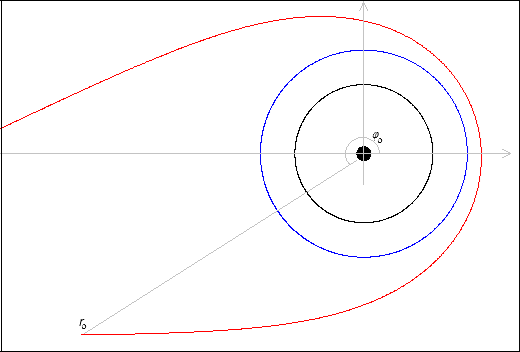
The origin of the polar coordinates is in the center of the black hole. The black circumference is the horizon whose radius is 2GM, while the blue circumference is the so-called circular orbit whose radius is 3GM (here G is the gravitational constant, and M the mass of the black hole).
Both model of photon motion for r(t) and r(φ) use a special impact parameter b preserving its value and defined in the following picture:
|
|
(1)
|
For convenience, we chose the point (r1, 3π/2) to define parameter b, which is the tangential component of the direction of motion a photon. It depends on the sin α so that α = π/2 means purely tangential motion.
The radial component (inward or outward) is determined by the proper choice of sign of the square roots in the formulas for dr/dt or du/dφ below (u = 1/r).
The approach as a trajectory r(t)
The original ODEs of a photon motion as r(t) are
|
|
(2) |
Remark 1: Two ODEs for r(t). The ODE for r contains the square root in the right-hand side with double signs representing the two branches of the complex function square root. It means that there are two ODEs for r(t) rather than one.
Remark 2: Singularity of the ODE. Both ODE for r have a branching singularity when the under-the-root expression becomes zero and this can happen. However, as we will demonstrate later, the ODE for r(t) belongs to those remarkable ODEs, which are singular, yet have regular solutions. For example, the ODE x' = nx/t is singular at t = 0. However, for natural n, it has a holomorphic solution x = tn. Moreover, there exists also a regular ODE x' = ntn 1 having the same solution. We will show, that there exists regular ODE also for r(t) which is holomorphic indeed. The solution r(t) may have stationary points where r'(t) = 0 because the under-the-root expression becomes zero. In such a case, r(t) may have an extremum, so that r'(t) changes the sign meaning that we must switch the sign at the square root both branches of which represent the same holomorphic solution r(t).
Remark 3: The Taylor integration method is inapplicable near the points of singularity; however, we will integrate the regular ODE (3) instead.
Remark 4: A quadrature. Here the variables t and φ are absent in the right-hand sides so that the ODE for r is uncoupled. As such, it has a quadrature the integral expressing t(r), though not in the Liouville elementary functions.
Remark 5: Approaching the horizon. In the cases when r(t) monotonously decreases to the horizon radius 2GM (a photon moves towards the horizon), the value in the parenthesis (2) gets closer and closer to zero in the process of integration of this ODE. Moreover, this system has a stationary solution r ≡ 2GM= const and φ = const (a point on the horizon, at which time stops in the lab frame). Any spiraling to the horizon solution approaches such a stationary point. Therefore, if the integration were infinitely accurate, we would see just that r(t) → 2GM and the value in the parenthesis (1 2GM/r) → 0 always remaining positive. However, due to inevitable rounding errors and finite number of digits, at certain step the parenthesis gets negative so that the further integration evolves into a numerical artefact with radius r increasing, having no physical meaning.
Remark 6: Approaching the extremal point. There is one more special situation in these ODEs when a photon escapes away from the black hole. Then, at the point when its distance rm to the origin is minimal, there must be that dr/dt = 0, which is possible only if the under-the-root expression is zero the singularity of the root. An attempt to integrate this ODE until point rm would inevitably fail, but we will get rid of the square root.
In order to rid of the square root, let's transform the first ODE into a second order ODE (having no singularities for any r > 0) by differentiating both sides of (2). Such a differentiation is particularly simple when applied to an ODE of the format (r')2 = f(r). Then 2r'r" = f'(r)r' so that 2r" = f'(r) and finally we get
|
|
(3) |
where

and the initial value for dr/dt is obtainable from the respective ODE (2) at any regular initial point.
At that, in terms of r, φ, the speed c of photon is
![]()
containing temporal derivatives of r and φ so that the speed of a photon (in the lab frame) varies in the vicinity of the black hole (rather than being the known constant c of the speed of light in the vacuum afar from any masses).
Below are results of integration of these ODEs for several special settings.

Circular approach of a photon (in red). The horizon is in black.

The graph of the speed c(r) of photon. The photon starts at the big radius (at the right)
and moves towards the circular orbit so that radius diminishes.
The vertical red line denotes the radius of the circular orbit. The blue line denotes the horizon.

Spiral fall of a photon (in red) towards the horizon (in black).
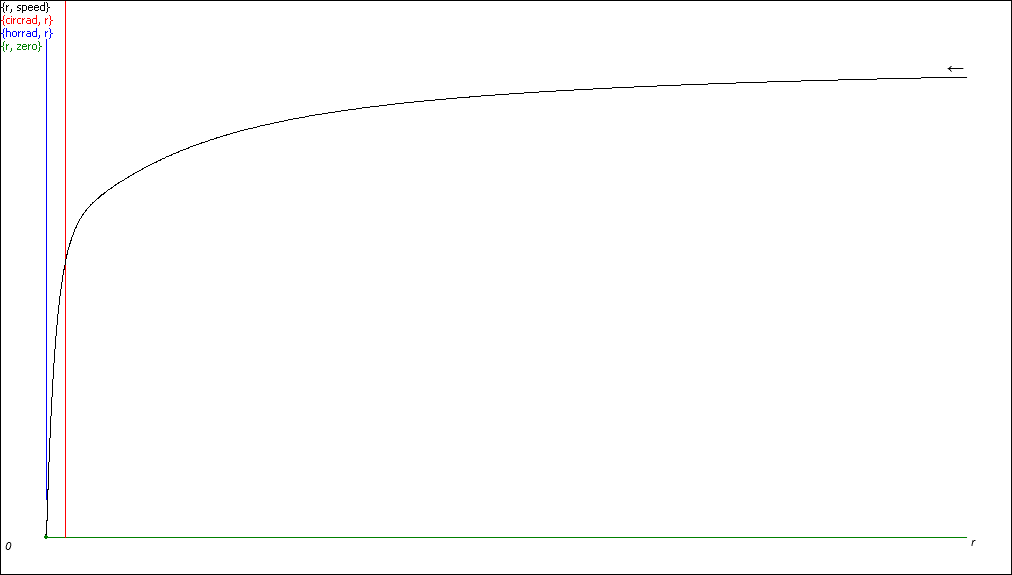
The graph of the speed c(r) of a photon which moves towards the center along a spiral so that radius diminishes.
The vertical red line denotes the radius of the circular orbit. The blue line denotes the horizon.
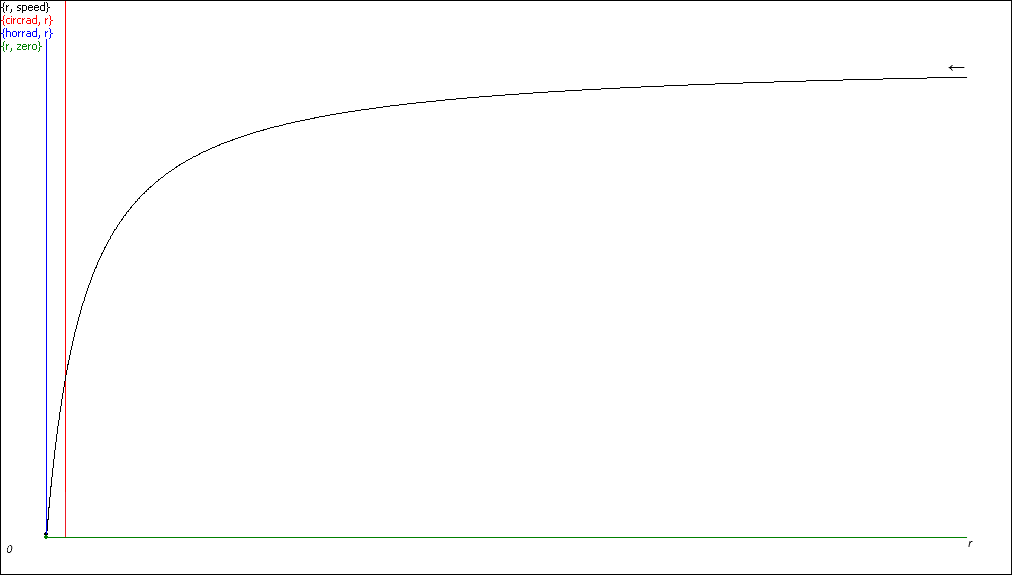
The graph of the speed c(r) of a photon which moves towards the center along a straight line so that radius diminishes.
The vertical red line denotes the radius of the circular orbit. The blue line denotes the horizon.
A puzzle
All three graphs of the varying speed c(r) of photon above are displayed as functions of radius-vector r, i.e. the distance from the center of the black hole. In all those cases we see that the speed of the photon monotonously decreases as the r decreases so that the photon gets closer to the horizon. At that, all the curves c(r) are clearly convex.
Now take the look at this combined graph of photon speed c(t) (green) as a function of t (the lab time), corresponding to the case when a photon spirals towards the horizon.

Here φ(t) is blue, r(t) is read, and photon speed c(t) is green. All three graphs are still monotonous, however, unlike before, now they all switch convexity/concavity in the process: of them, c(t) does it most steeply.
This behavior takes place only for the case of a photon spiraling to the horizon. For the cases of circular orbit and the straight line towards the center, the shape of the speed c(t) looks similar to that of c(r) in all the three cases.
Why is the case of spiraling so special?
It's instructive how Copilot answered to this enigma "with straight face" and "scientific air". The answer happened to be a complete blunder.
The expression for the speed of photon is
![]()
meaning that c(r) or c(r(t)) depend only on r (as an independent variable), or on r(t): not on φ, as Copilot speculated. We can obtain either ∂2/ ∂r2, or d2/dt2 of the expression for c (the latter expression will be more cumbersome than the former), and ask where these second-order derivatives turn zero. So far, we know, that for the spiral case, c(r) does not have inflection points, while c(t) does.
The approach as a path r(φ)
In this model the ODE is simpler. The ODE was originally written for u(φ) = 1/r(φ):
 .
.
Remark 5: Here the variable φ is absent in the right-hand side so that this ODE has a quadrature as an integral for φ(u), though not in the Liouville elementary functions.
Remark 6: Also here, at the point when the distance rm of a photon to the origin gets minimal (and um= 1/rm gets maximal), it must be that du/dφ = 0, possible only if the under-the-root expression gets zero the singularity of the root. An attempt to integrate this ODE until point rm would inevitably fail. We must try to get rid of the square root also here.
As before, we transform it into an ODE of order two eliminating the radical:
u" = 3GMu2 u
Not only is this ODE simpler than those for the temporal model, but it also uncovers a deeper reality: literally. The picture below replicates the case of a spiral fall considered above, but unlike there

now the red path of a photon penetrates inside the horizon until reaching the center of the black hole. Wow! That's the new reality! This is possible because, unlike the temporal model above, where the lab time stops at the horizon, this ODE describes merely the path of the photon motion which surely moves on also after crossing the horizon.
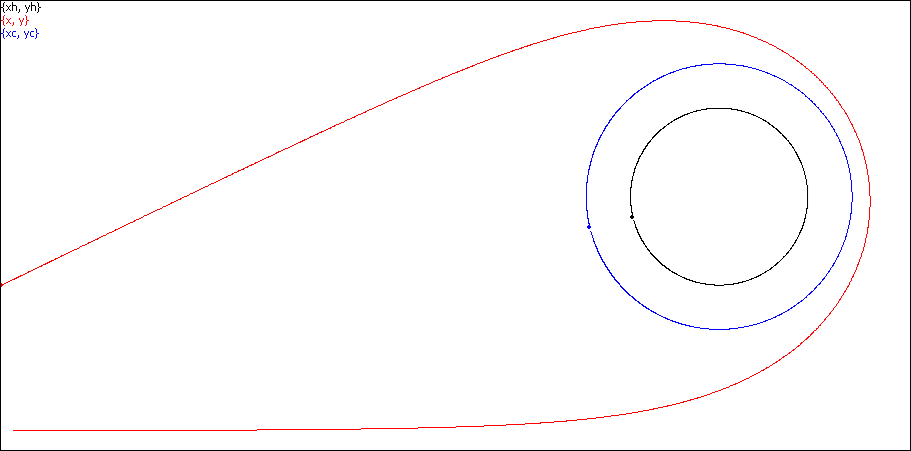
Here a photon makes a U-turn
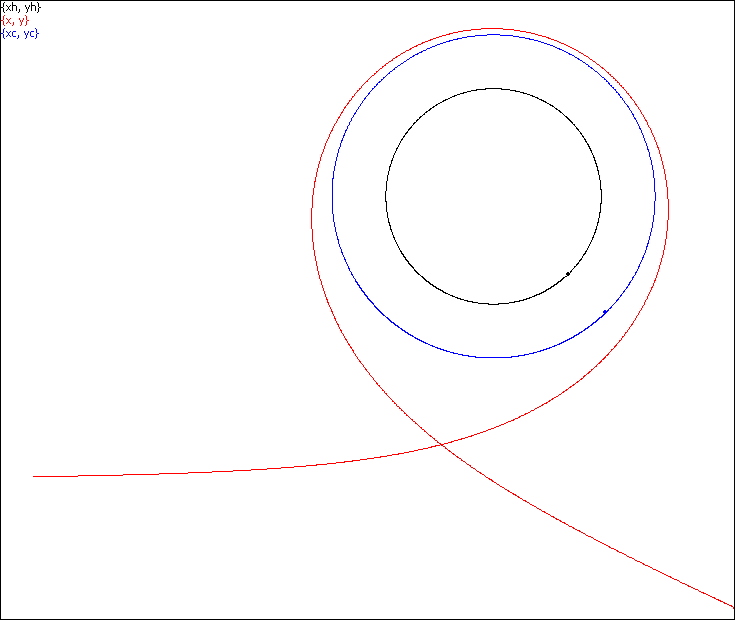
And here the path replicates letter γ upside-down.
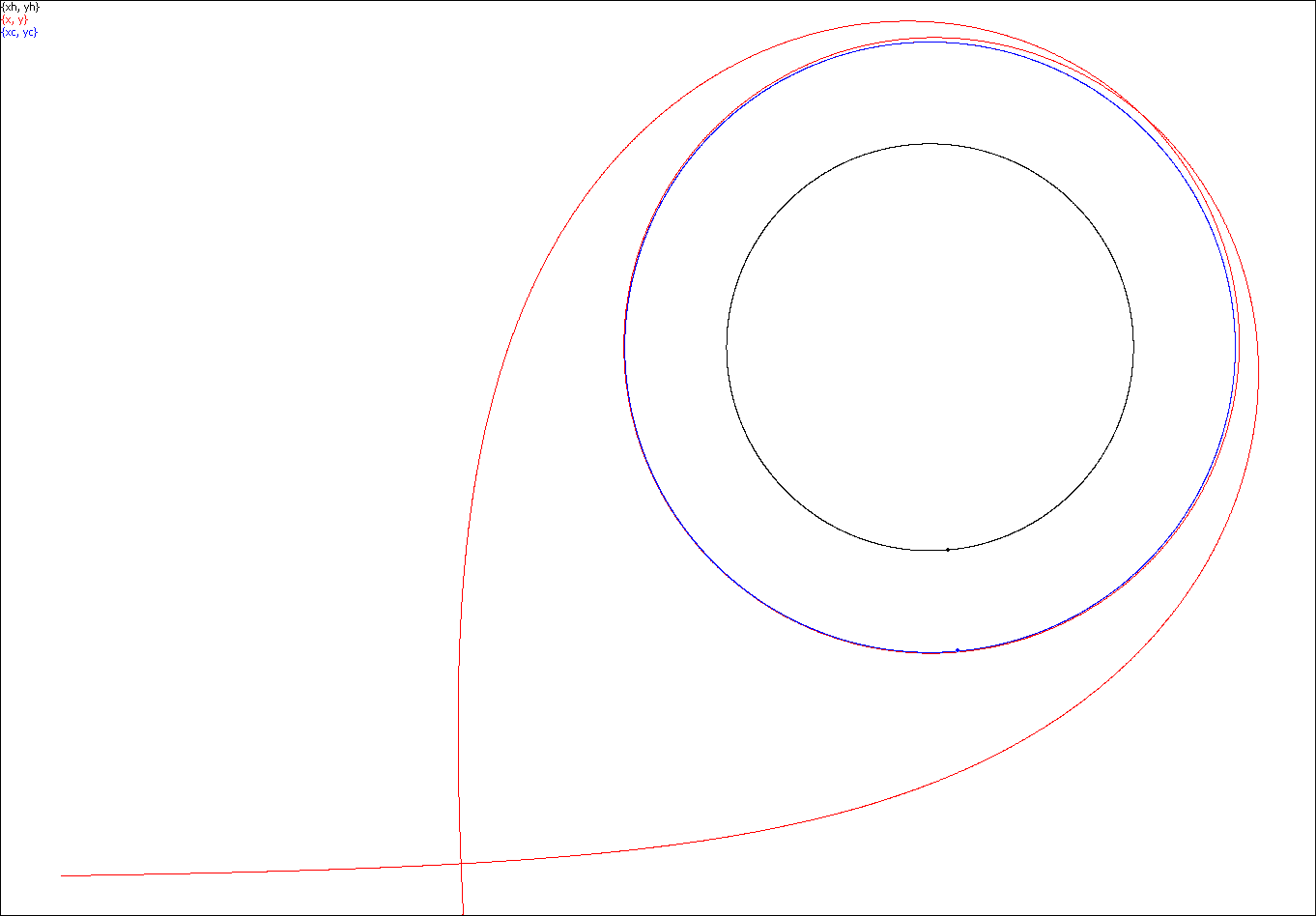
Approach to and escape off the circular orbit
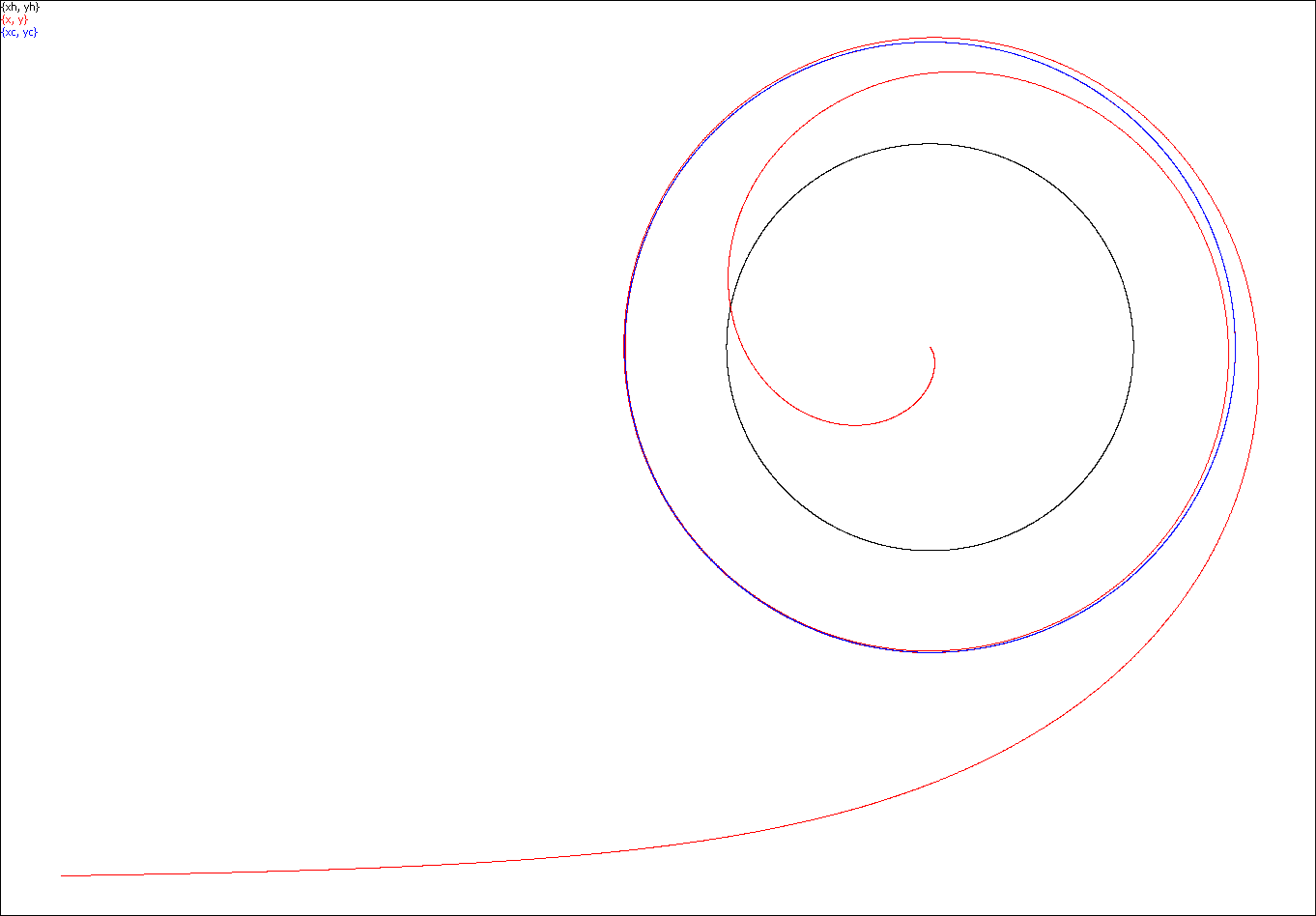
Approach to and capture by the circular orbit
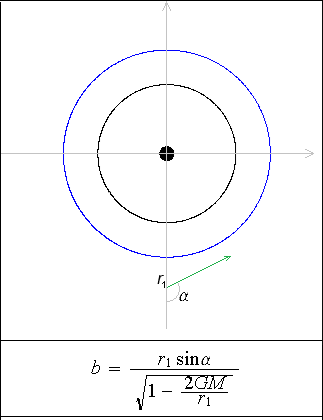
Formula.png)
